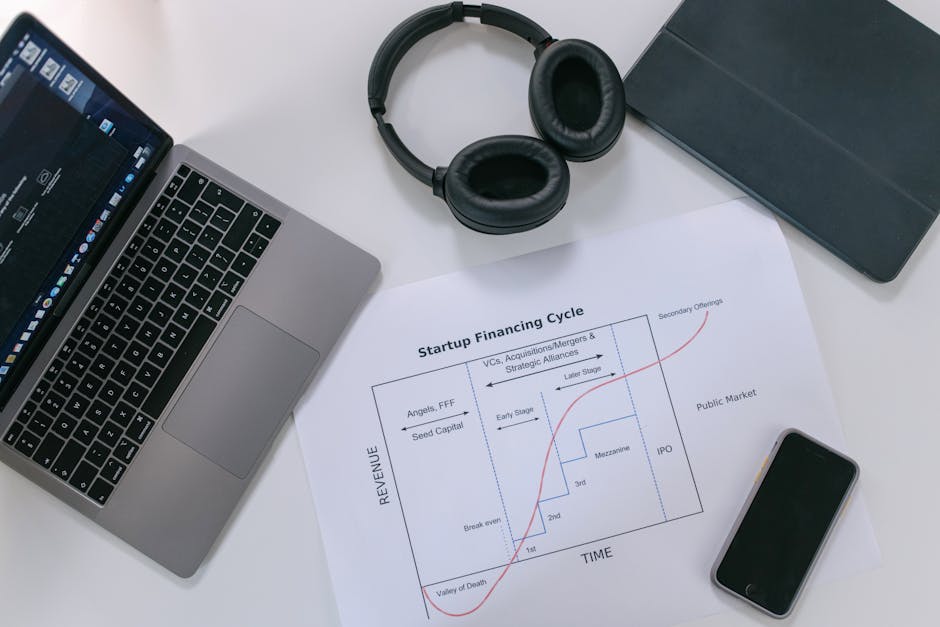10 Key Strategies for Lean Start-up Product Development
Do you want to revolutionise your product development?
Dive into these 10 key strategies for lean start-up success.
Embrace customer feedback, rapidly prototype, and iterate with agility.
Design with the user in mind, make data-driven decisions, and build for scalability.
Let’s innovate and disrupt the market together.
Key Takeaways
- Embrace a customer-centric approach by actively seeking customer feedback and conducting thorough market research to understand their challenges, preferences, and unmet needs.
- Implement an iterative development process, such as Agile methodologies and A/B testing, to continuously refine the product based on feedback and address specific pain points.
- Focus on lean principles and efficiency by prioritising value creation, waste elimination, and resource optimisation, and by promoting a culture of continuous learning, experimentation, and innovation.
- Ensure scalability and future-proofing by enabling quick adaptation to changing market conditions and customer needs, preparing for future growth and technological advancements, and reducing the need for major rework or redevelopment.
Customer Development

Developing a deep understanding of customer needs and pain points is crucial for creating successful products in lean start-up product development. This involves actively seeking customer feedback and conducting thorough market research to uncover valuable insights.
By engaging directly with your target audience, you can gain a clearer understanding of their challenges, preferences, and unmet needs. This customer-centric approach allows you to identify opportunities for innovation and tailor your product to address specific pain points.
Customer feedback serves as a guiding light, illuminating the path toward creating solutions that truly resonate with your market.
In the realm of lean start-up product development, market research plays a pivotal role in validating assumptions and shaping product direction. By leveraging various research methods such as surveys, interviews, and data analysis, you can gather actionable intelligence that informs your product strategy.
This data-driven approach not only minimises the risk of building products that miss the mark but also increases the likelihood of delivering solutions that genuinely resonate with the intended audience.
Embracing customer feedback and market research empowers you to make informed decisions that drive innovation and ultimately lead to the creation of successful, customer-centric products.
Problem-Solution Fit

Now it’s time to focus on achieving Problem-Solution Fit.
This involves validating the market need and utilising iterative problem solving.
Validating Market Need
To validate market need (problem-solution fit), you should engage directly with potential customers to understand their pain points and determine if your solution addresses their needs effectively. Conducting thorough market research and customer interviews is crucial at this stage. By gathering insights from your target audience, you can identify whether there is a real demand for your product or service. Use these interactions to validate your assumptions about the problem you are solving and the value proposition you are offering. This process will help you refine your product to ensure it resonates with the market. Below is an example of how you can organise the information gathered from customer interviews:
| Pain Points | Solution Effectiveness |
|---|---|
| Customer A | Solution A |
| Customer B | Solution B |
| Customer C | Solution C |
| Customer D | Solution D |
| Customer E | Solution E |
Iterative Problem Solving
Engage in iterative problem solving to continuously refine your product’s problem-solution fit by seeking feedback from your target audience. Continuous improvement is key to ensuring that your product effectively addresses the needs of your customers.
Here are some problem-solving techniques to help you achieve problem-solution fit:
- Conduct regular customer interviews and surveys to gather feedback on pain points and preferences.
- Utilise A/B testing to compare different versions of your product and determine which resonates best with your audience.
- Analyse user data and behaviour to identify areas for improvement and innovation.
- Implement a feedback loop to incorporate suggestions and address issues promptly.
Minimum Viable Product (MVP)

When developing your lean start-up product, focus on creating an MVP that addresses the core needs of your target customers. MVP testing is a crucial step in lean development strategies, allowing you to validate your product hypotheses with real user feedback. By focussing on the essential features that solve the primary problem for your customers, you can quickly bring a viable product to market and gather valuable insights for further iterations.
Incorporating lean development strategies into your MVP approach enables you to test your assumptions, learn from the feedback, and iterate rapidly. This iterative process not only helps in refining your product but also saves time and resources by avoiding unnecessary features that may not resonate with your target audience.
By embracing the MVP mindset, you can minimise the risk of building a product that doesn’t meet customer needs. It empowers you to make data-driven decisions, prioritise features based on user feedback, and ultimately deliver a solution that resonates with your target market.
Embracing MVP testing and lean development strategies will set you on the path to creating innovative products that truly address the core needs of your customers.
Rapid Prototyping

When developing your product, rapid prototyping allows you to quickly iterate through design phases, minimising time investment and maximising efficiency.
This iterative process enables you to test and refine your product ideas in a fraction of the time it would take with traditional development methods.
Iterative Design Process
To effectively implement the iterative design process in lean start-up product development, start by creating rapid prototypes to test and refine your ideas quickly. Embrace design iteration and the testing phase, ensuring continuous improvement based on user feedback.
Here are four essential strategies for successful iterative design:
-
Empower Cross-Functional Teams: Encourage collaboration between different departments to bring diverse perspectives and skill sets to the design process.
-
Prioritise Speed and Agility: Emphasise quick turnarounds and rapid decision-making to expedite the iterative design process.
-
Utilise Agile Methodologies: Implement agile frameworks like Scrum or Kanban to streamline the iterative design process and foster adaptability.
-
Leverage Rapid Prototyping Tools: Capitalise on advanced prototyping tools and technologies to swiftly transform ideas into tangible prototypes for user testing.
By embracing these strategies, you can effectively navigate the iterative design process and accelerate product development.
Now, let’s delve into minimising time investment in lean start-up product development.
Minimise Time Investment
Streamline your product development process by rapidly prototyping your ideas to minimise time investment and swiftly validate concepts. Efficient resource allocation and streamlined project management are essential for lean start-up success. Rapid prototyping allows you to quickly create a basic version of your product, gather feedback, and make necessary improvements without investing extensive time and resources. By adopting this approach, you can accelerate the product development cycle, identify potential issues early on, and ensure that your final product meets the needs of your target market. Cheque out the table below for a comparison of traditional product development methods versus rapid prototyping.
| Aspect | Traditional Product Development | Rapid Prototyping |
|---|---|---|
| Time Investment | Lengthy | Minimal |
| Resource Allocation | High | Efficient |
| Flexibility | Limited | High |
| Feedback Incorporation | Slow | Rapid |
| Risk of Failure | Higher | Lower |
Continuous Iteration

By consistently gathering and incorporating user feedback, you can refine your product through continuous iteration, ensuring it meets market needs and evolves with customer preferences. This approach fosters a culture of continuous improvement and allows for rapid adjustments based on feedback loops. Embracing continuous iteration empowers your team to stay nimble and responsive, ultimately driving innovation and customer satisfaction.
Here are key strategies for successful continuous iteration:
-
Embrace Agile Methodologies: Adopt agile practises to enable rapid development cycles and the ability to pivot based on user feedback.
-
Implement A/B Testing: Utilise A/B testing to compare different versions of your product or features, allowing you to make data-driven decisions and continuously improve.
-
Regular User Testing: Conduct regular user testing to gather valuable insights and identify areas for improvement, ensuring that your product stays alined with user needs and preferences.
-
Cross-Functional Collaboration: Foster collaboration between different teams within your organisation to ensure that feedback from all areas is considered and integrated into the product development process.
Product-Market Fit

You should aim to achieve a clear product-market fit early in your start-up’s journey to ensure that your solution resonates with the target audience and addresses their specific needs. Achieving product-market fit involves conducting thorough product market analysis and customer segmentation to understand the specific needs and preferences of your target market. This is where market research and customer feedback play a crucial role. By gathering insights and feedback directly from your target audience, you can fine-tune your product to better aline with their requirements.
| Key Strategies for Product-Market Fit || — | — | — || Product Market Analysis | Customer Segmentation | Market Research || Conduct in-depth analysis of the market to identify trends, competition, and unmet needs. | Segment your target audience based on demographics, behaviour, and psychographics. | Gather data on customer preferences, pain points, and buying behaviour to inform product development. |
Agile Development

You’ll find that Agile Development emphasises an iterative approach for agility, enabling you to make continuous improvements as you gather feedback from users.
This method promotes rapid feedback loops, allowing you to quickly adapt and refine your product based on real-world insights.
With its flexibility in processes, Agile Development empowers you to respond to changes in market demands and customer needs efficiently.
Iterative Approach for Agility
When developing your product using a lean start-up approach, adopting an iterative approach for agility, also known as Agile Development, is crucial for adapting to changes and feedback efficiently. Embracing Agile Development fosters a culture of continuous improvement and innovation.
Here’s how to make the most of it:
-
Sprint Planning: Break down the product development into short, manageable sprints to ensure flexibility and responsiveness to customer needs.
-
Daily Stand-ups: Conduct brief daily meetings to keep the team alined, share progress, and address any roadblocks promptly.
-
Feedback Loops: Integrate regular feedback loops to gather insights and adjust the product accordingly, ensuring it meets customer expectations.
-
Retrospectives: Hold regular retrospectives to reflect on what worked well and what could be improved, fostering a culture of continuous learning and enhancement.
Rapid Feedback Loops
To achieve rapid feedback loops in Agile Development, employ frequent iterations and customer involvement to refine your product efficiently. Continuous improvement is key in ensuring that your product meets the ever-changing needs of your target market. Real-time testing allows you to gather immediate feedback and make necessary adjustments quickly. By incorporating customer feedback into each iteration, you can ensure that your product alines with market demands. The table below illustrates the benefits of rapid feedback loops in Agile Development.
| Benefits of Rapid Feedback Loops || — | — || 1. Accelerated Innovation || 2. Increased Customer Satisfaction || 3. Reduced Time to Market || 4. Enhanced Product Quality |
Flexibility in Processes
Employing flexibility in processes within Agile Development allows for swift adaptation to changing market demands and customer feedback, ensuring the continuous improvement of your product. Embracing flexible planning and adaptable workflows enables your team to respond quickly to new insights and adjust priorities as needed.
Here’s how flexibility in processes can benefit your product development:
-
Rapid iteration cycles allow for frequent testing and iteration, leading to faster improvements.
-
Continuous feedback loops from customers and stakeholders ensure that your product remains alined with market needs.
-
Agile development fosters a culture of collaboration and innovation, empowering teams to solve problems creatively.
-
Adaptable workflows enable you to pivot and seise new opportunities, staying ahead in dynamic markets.
User-Centric Design

As you develop your product in a lean start-up framework, it’s essential to prioritise user-centric design to ensure that your solution meets the specific needs and preferences of your target audience. User feedback should be at the core of your design process, allowing you to gather valuable insights that can drive iterative improvement. By actively involving your target users in the design and development phases, you can create a product that resonates with their expectations and addresses their pain points effectively.
Incorporating user-centric design principles into your lean start-up approach not only fosters a deeper understanding of your users’ needs but also enables you to build a more intuitive and impactful solution. Embracing an iterative improvement approach based on continuous user feedback empowers you to make informed decisions and adapt your product to evolving market demands.
Data-Driven Decision Making

You should leverage data-driven decision making to drive the development and improvement of your lean start-up product. By utilising data analysis and performance metrics, you can make informed decisions that are crucial for the success of your product.
Here are four key strategies to effectively implement data-driven decision making:
-
Define clear performance metrics: Establish specific and measurable key performance indicators (KPIs) that aline with your business goals. This will provide you with a clear understanding of how your product is performing and where improvements are needed.
-
Gather relevant data: Collect both quantitative and qualitative data from various sources such as user interactions, market trends, and customer feedback. This will give you a comprehensive view of how your product is being perceived and used.
-
Analyse data for insights: Use advanced analytics tools to dissect the gathered data and extract valuable insights. By identifying patterns and trends, you can uncover opportunities for product optimisation and innovation.
-
Implement iterative improvements: Continuously iterate and improve your product based on the insights gained from data analysis. This agile approach will enable you to adapt to changing market demands and user needs, driving innovation and enhancing the overall product experience.
Scalable Architecture

Utilise a scalable architecture to ensure that your lean start-up product can accommodate increasing user demand and evolving technological requirements. Scalable architecture alines with lean principles by allowing you to build a flexible and adaptable foundation for your product.
By designing your system to handle growth without sacrificing performance, you can respond to changing market conditions and customer needs more effectively. Implementing scalable architecture from the outset enables your product to seamlessly scale up or down, optimising resource utilisation and cost-efficiency.
Using cloud-based services, microservices, and containerisation can help you achieve scalability while maintaining agility and innovation. Embracing a modular approach to development and infrastructure empowers your team to make incremental improvements, iterate quickly, and pivot in response to feedback. This approach alines with lean principles by promoting continuous improvement and reducing waste.
Scalable architecture not only future-proofs your product but also fosters a culture of innovation and adaptability, essential for the success of a lean start-up in a dynamic market landscape.
Frequently Asked Questions
How Can Lean Start-up Strategies Be Applied to Industries Outside of Technology and Software Development?
You can apply lean start-up strategies in manufacturing by focussing on rapid prototyping and customer feedback. In the healthcare industry, use lean principles to create MVPs and iterate based on patient needs.
What Are Some Common Pitfalls to Avoid When Implementing Lean Start-up Principles in Product Development?
When diving into lean start-up strategies for product development, steer clear of common pitfalls like overcommitting to a single idea, neglecting customer feedback, and scaling too quickly. Successful implementation hinges on adaptability and continuous iteration.
What Role Does Leadership and Team Dynamics Play in Successfully Implementing Lean Start-up Strategies?
In successfully implementing lean start-up strategies, leadership dynamics are crucial. Your team’s collaboration and adaptability are key. Engage in open communication, foster a culture of experimentation, and empower your team to make decisions.
How Can Lean Start-up Principles Be Integrated With Traditional Project Management Methodologies?
You can blend the best of both worlds by integrating traditional project management methodologies with lean start-up principles. Embrace agile collaboration, infuse lean start-up innovation, and find harmony in waterfall integration for a dynamic approach.
What Are Some Best Practises for Measuring and Tracking the Success of Lean Start-up Product Development Initiatives?
To measure success in lean start-up product development, focus on KPI tracking. Embrace continuous improvement and iterative development to adapt quickly. Gather real-time data, set clear benchmarks, and adjust strategies as needed for optimal results.
Conclusion
You’ve learnt the key strategies for lean start-up product development.
Did you know that 74% of high-growth start-ups use rapid prototyping to quickly test and iterate on their product ideas?
By implementing these strategies, you can increase your chances of success and create products that truly meet the needs of your customers.
Keep innovating and iterating to stay ahead in the competitive start-up landscape.
Contact us to discuss our services now!
